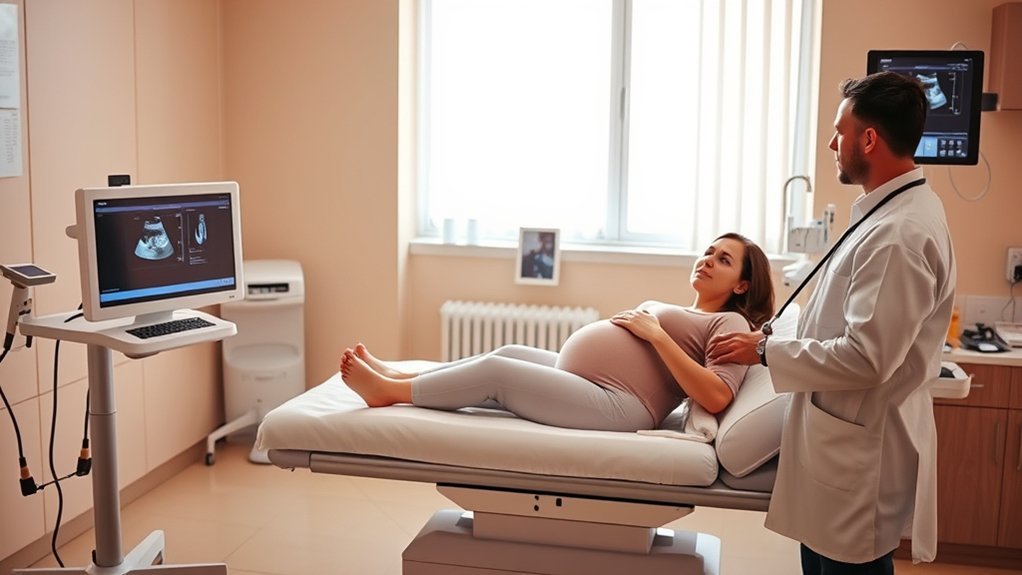Preeclampsia is a serious condition that can impact both you and your baby during pregnancy. Recognizing the signs, like high blood pressure and sudden swelling, is vital for ensuring safety. It’s important to understand how these symptoms could affect your journey and what steps you might need to take. As you navigate this experience, knowing when to seek help can make a significant difference in outcomes. What should you look out for next?
Understanding Preeclampsia: An Overview

Understanding preeclampsia is important for expecting parents, especially since it can develop suddenly during pregnancy.
Preeclampsia is a serious condition characterized by high blood pressure and potential damage to essential organs, typically occurring after the 20th week. It affects both you and your baby, necessitating careful monitoring.
The exact cause remains unclear, but risk factors include a history of preeclampsia, obesity, and multiple pregnancies. Early detection is significant, as it can progress to severe complications if left untreated.
Regular prenatal check-ups help guarantee your healthcare provider can identify any issues early on. By staying informed and proactive, you can better navigate this potential risk during your pregnancy, safeguarding both your health and your baby’s well-being.
Common Symptoms of Preeclampsia

As you navigate your pregnancy, it’s important to be aware of the common symptoms of preeclampsia.
High blood pressure and significant swelling, particularly in your hands and face, can indicate the condition.
Recognizing these signs early can help guarantee you and your baby receive the necessary care.
High Blood Pressure
High blood pressure is one of the key indicators of preeclampsia, affecting approximately 5-8% of pregnancies. You may notice elevated blood pressure readings, often defined as 140/90 mmHg or higher. This can occur after the 20th week of pregnancy and may develop suddenly.
It’s vital to monitor your blood pressure closely during prenatal visits, as consistent high readings can signal potential complications for both you and your baby. If you experience headaches, visual disturbances, or sudden changes in blood pressure, reach out to your healthcare provider immediately.
Early detection and management of high blood pressure can greatly reduce risks, ensuring a healthier pregnancy. Remember, your well-being is essential for both you and your growing child.
Swelling and Edema
Swelling and edema are common symptoms that can indicate preeclampsia during pregnancy. You might notice swelling in your hands, feet, or face, which can be concerning. While some swelling is normal in pregnancy, sudden or severe changes warrant immediate attention.
| Symptom | Normal Pregnancy | Preeclampsia Indicator |
|---|---|---|
| Hand Swelling | Mild | Severe or sudden |
| Foot Swelling | Common | Sudden increase |
| Facial Swelling | Rare | Noticeable and sudden |
| Weight Gain | Gradual | Rapid gain (>2 lbs/week) |
| Leg Swelling | Mild | Severe or painful |
If you’re experiencing unusual swelling, reach out to your healthcare provider. Early detection can help protect both you and your baby.
Risk Factors for Developing Preeclampsia

Understanding the risk factors for developing preeclampsia is essential for your health and your baby’s well-being.
If you’ve had preeclampsia in a previous pregnancy, or if you have existing high blood pressure issues, your chances of experiencing it again increase.
Additionally, carrying multiples can elevate your risk, so it’s important to stay informed and discuss any concerns with your healthcare provider.
Previous Preeclampsia History
If you’ve experienced preeclampsia in a previous pregnancy, you’re at a higher risk of developing it again in subsequent pregnancies. This history plays a significant role in your overall pregnancy health.
Studies show that women with a past diagnosis of preeclampsia can face recurrence rates of 15% to 50%. It’s important to communicate this history with your healthcare provider, as they can monitor you closely and implement preventive measures.
Additionally, factors such as the severity of your previous condition and the gestational age at which it occurred can influence your risk level. Understanding these risks helps you and your provider make informed decisions to promote a healthier pregnancy journey.
Stay proactive and prioritize your health for the best outcomes.
High Blood Pressure Issues
High blood pressure issues considerably increase your risk of developing preeclampsia during pregnancy. Understanding these risks can help you take proactive steps for your health and your baby’s well-being.
Here are some factors to contemplate:
- Chronic hypertension: If you’d high blood pressure before pregnancy.
- Weight: Being overweight can elevate your blood pressure.
- Age: Women over 35 are at higher risk.
- Family history: A background of high blood pressure in your family increases your odds.
- Lifestyle choices: Poor diet, lack of exercise, and smoking can contribute to hypertension.
Being aware of these risk factors allows you to discuss them with your healthcare provider, ensuring you receive the appropriate monitoring and care throughout your pregnancy.
Multiple Pregnancy Factors
While many factors contribute to the risk of developing preeclampsia during pregnancy, certain multiple pregnancy factors are particularly significant. If you’re carrying more than one baby, your chances of developing this condition increase. Additionally, if you’ve had preeclampsia in a previous pregnancy or are experiencing a new pregnancy later in life, your risk elevates. Understanding these factors can help you and your healthcare provider monitor your health more closely.
| Pregnancy Factor | Risk Level |
|---|---|
| Multiple gestation | Increased risk |
| History of preeclampsia | Elevated risk |
| Advanced maternal age | Higher risk |
Recognizing these factors allows for proactive management and better outcomes for you and your babies.
The Importance of Regular Prenatal Checkups
Regular prenatal checkups are crucial for monitoring both your health and your baby’s development throughout pregnancy. These appointments allow healthcare providers to detect potential issues early, including signs of preeclampsia.
By attending these checkups, you guarantee that:
- Your blood pressure is consistently monitored.
- Urine tests check for protein levels indicating kidney function.
- Ultrasounds track your baby’s growth and development.
- Blood tests assess your overall health and identify any deficiencies.
- You receive important guidance on nutrition and lifestyle adjustments.
Staying committed to regular prenatal visits empowers you with knowledge, helping you respond to changes promptly and fostering a safer pregnancy experience.
Prioritize these checkups to safeguard both your well-being and your baby’s future.
How Preeclampsia Affects the Mother
Preeclampsia can markedly impact your health, often presenting with symptoms that can escalate quickly if left unmonitored. You may experience elevated blood pressure, swelling, and sudden weight gain.
These signs indicate your body is under stress, requiring immediate medical attention. If untreated, you risk severe complications, including organ damage or stroke.
Additionally, you might feel anxious or overwhelmed as you navigate these health challenges. It’s vital to monitor your symptoms closely and communicate openly with your healthcare provider.
They’ll guide you through managing your condition and ensuring your well-being. Remember, prioritizing your health is essential for both you and your baby. Seeking timely care can appreciably improve your outcome during this critical time.
Potential Risks for the Baby
When preeclampsia develops, it can pose significant risks to your baby’s health. Understanding these risks can help you prepare for potential challenges.
Preeclampsia can lead to serious risks for your baby’s health; being informed prepares you for potential challenges.
Some potential complications include:
- Low birth weight: Your baby may not grow as expected, leading to health issues.
- Preterm birth: Early delivery might be necessary to protect both of you.
- Placental abruption: The placenta could separate from the uterus, causing severe complications.
- Fetal distress: Changes in your baby’s heart rate may signal a lack of oxygen.
- Stillbirth: In severe cases, the risk of stillbirth increases.
Being aware of these risks allows you to work closely with your healthcare team to guarantee the best possible outcome for you and your baby.
Diagnosing Preeclampsia: What to Expect
Diagnosing preeclampsia typically involves a combination of monitoring your blood pressure and testing your urine. Your healthcare provider will regularly check your blood pressure during prenatal visits, looking for readings above 140/90 mmHg.
Alongside this, they’ll test your urine for protein, which can indicate kidney issues associated with preeclampsia. You may also undergo blood tests to evaluate liver and kidney function, as well as platelet levels.
If symptoms like severe headaches, vision changes, or swelling appear, it’s vital to report these to your doctor. Early diagnosis is key to managing potential complications, and your healthcare team is there to support you through this process.
Management and Treatment Options
Managing preeclampsia involves a combination of lifestyle modifications and targeted medical interventions.
You can play a crucial role in your care by adjusting your diet, monitoring your blood pressure, and following your healthcare provider’s recommendations.
Understanding these options can help you and your provider create a plan that prioritizes your health and that of your baby.
Lifestyle Modifications
Although traversing the challenges of preeclampsia can be intimidating, implementing lifestyle modifications can greatly enhance your health and well-being during pregnancy.
By making certain adjustments, you can help manage your symptoms and support your body:
- Maintain a balanced diet rich in fruits, vegetables, and whole grains.
- Stay hydrated by drinking plenty of water throughout the day.
- Engage in regular, gentle exercise like walking or prenatal yoga.
- Monitor your blood pressure regularly to keep track of any changes.
- Prioritize rest and stress management through relaxation techniques such as meditation.
These modifications can’t only improve your physical health but also provide emotional reassurance as you navigate this journey.
Medical Interventions
While lifestyle modifications play an essential role in supporting your health during pregnancy, medical interventions may be necessary for managing preeclampsia effectively.
Your healthcare provider might recommend monitoring your blood pressure closely and performing regular blood tests to assess kidney and liver function. Depending on the severity, medications such as antihypertensives can help lower your blood pressure and reduce risks.
In some cases, corticosteroids may be prescribed to enhance fetal lung maturity if early delivery is needed. If your condition worsens or poses significant risks, your doctor may suggest delivering the baby, even if it’s preterm.
It’s vital to communicate openly with your healthcare team to guarantee the best outcomes for you and your baby during this challenging time.
Lifestyle Changes to Reduce Risk
Making lifestyle changes can greatly reduce the risk of developing preeclampsia during pregnancy. By adopting healthier habits, you can support your body and your growing baby.
Here are some effective strategies:
- Maintain a balanced diet rich in fruits, vegetables, whole grains, and lean proteins.
- Stay hydrated by drinking plenty of water throughout the day.
- Engage in regular physical activity like walking, swimming, or prenatal yoga.
- Monitor your blood pressure regularly to catch any changes early.
- Prioritize rest and stress management through mindfulness practices or gentle exercises.
These changes not only promote overall health but also contribute to a safer pregnancy.
When to Seek Immediate Medical Attention
Even with healthy lifestyle changes in place, it’s important to stay vigilant about your health during pregnancy. If you experience any of the following signs, seek immediate medical attention:
| Symptom | Possible Indicator | Action Required |
|---|---|---|
| Severe headache | Preeclampsia risk | Contact your doctor |
| Vision changes | Potential complications | Go to the emergency room |
| Sudden swelling | Edema or hypertension | Alert a healthcare provider |
| Upper abdominal pain | Liver involvement | Seek urgent care |
Recognizing these symptoms can be essential for your well-being and your baby’s. Don’t hesitate to reach out to your healthcare provider if you’re concerned. Early intervention can make a significant difference.
Frequently Asked Questions
Can Preeclampsia Develop After Childbirth?
Yes, preeclampsia can develop after childbirth, a condition known as postpartum preeclampsia. It’s essential to monitor your health closely during this time, as symptoms can arise even days or weeks post-delivery. Stay informed and vigilant.
Is Preeclampsia Hereditary?
Yes, preeclampsia can have hereditary factors. If you’ve had a family history of preeclampsia, your risk may increase. It’s important to discuss your concerns with your healthcare provider for personalized guidance and monitoring.
How Does Preeclampsia Affect Future Pregnancies?
Preeclampsia can lead to increased risks in future pregnancies, like hypertension and preterm birth. Wouldn’t you want to discuss your history with your healthcare provider? Monitoring and management are essential for healthier outcomes in subsequent pregnancies.
What Lifestyle Changes Can Prevent Preeclampsia?
To prevent preeclampsia, you should maintain a healthy diet, exercise regularly, manage stress, monitor blood pressure, and avoid smoking. These lifestyle changes can considerably lower your risk and promote a healthier pregnancy overall.
Are There Natural Remedies for Preeclampsia?
There aren’t proven natural remedies for preeclampsia, but maintaining a healthy diet, staying hydrated, and managing stress may help support overall health. Always consult your healthcare provider before trying any alternative treatments or therapies.
Conclusion
Recognizing the signs of preeclampsia is essential for ensuring a safe journey through pregnancy. Just as Odysseus navigated treacherous waters, you too can steer clear of complications by staying informed and vigilant. By understanding symptoms, attending regular checkups, and seeking help when needed, you protect both your health and your baby’s. Trust your instincts and don’t hesitate to reach out to healthcare professionals—timely intervention can make all the difference in this vital chapter of your life.
